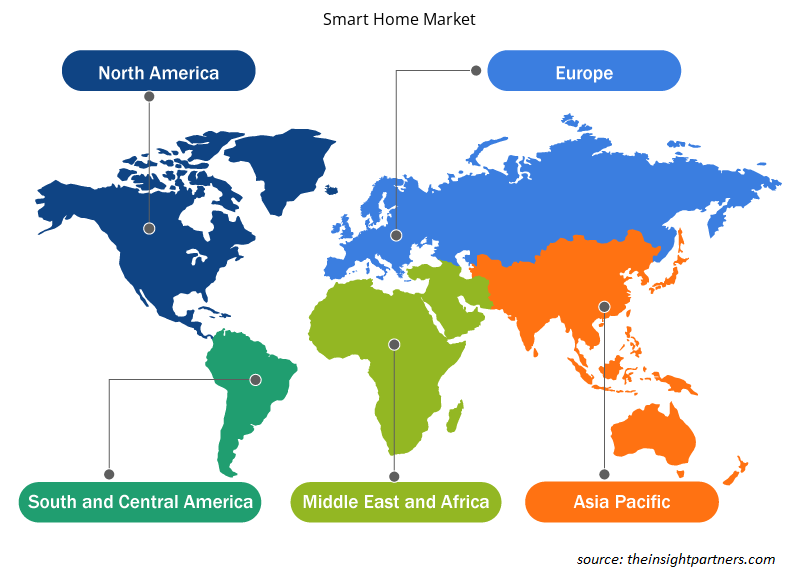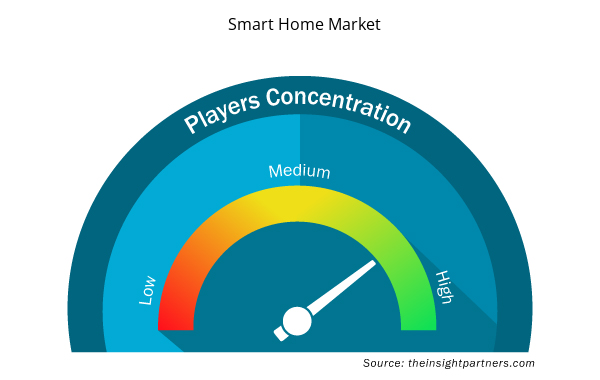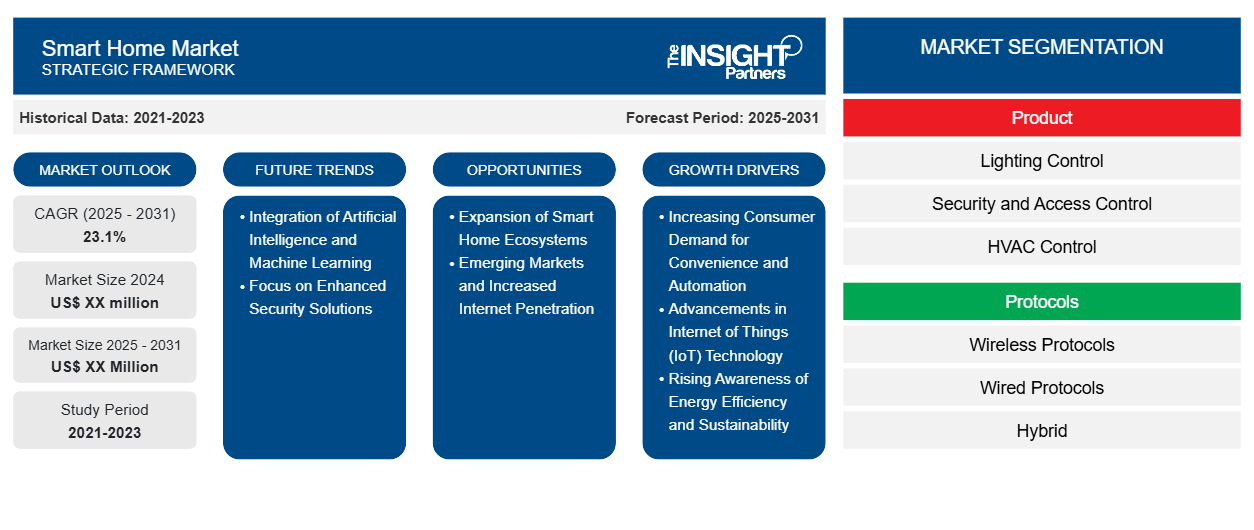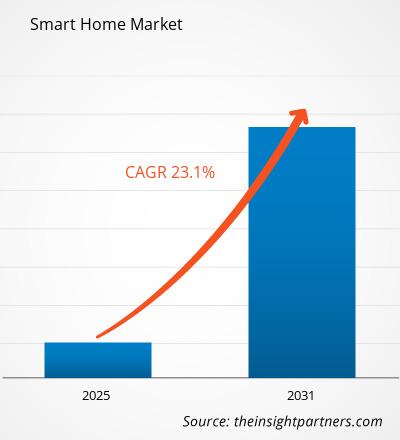Es wird erwartet, dass der Smart-Home-Markt von 2024 bis 2031 eine durchschnittliche jährliche Wachstumsrate (CAGR) von 23,1 % verzeichnet und dass die Marktgröße von XX Millionen US-Dollar im Jahr 2024 auf XX Millionen US-Dollar im Jahr 2031 anwächst.
Der Bericht ist segmentiert nach Produkt (Lichtsteuerung, Sicherheits- und Zugangskontrolle, HLK-Steuerung, Energiemanagement, Sonstiges); Protokollen (Drahtlose Protokolle, drahtgebundene Protokolle, Hybrid); Anwendung (Neubau, Nachrüstung). Die globale Analyse ist weiter auf regionaler Ebene und in den wichtigsten Ländern aufgeschlüsselt. Der Bericht bietet den Wert in USD für die oben genannte Analyse und die Segmente
Zweck des Berichts
Der Bericht Smart Home Market von The Insight Partners soll die aktuelle Landschaft und das zukünftige Wachstum sowie die wichtigsten treibenden Faktoren, Herausforderungen und Chancen beschreiben. Dies wird verschiedenen Geschäftspartnern Einblicke geben, wie zum Beispiel:
- Technologieanbieter/-hersteller: Um die sich entwickelnde Marktdynamik zu verstehen und die potenziellen Wachstumschancen zu kennen, damit sie fundierte strategische Entscheidungen treffen können.
- Investoren: Durchführung einer umfassenden Trendanalyse hinsichtlich der Marktwachstumsrate, der finanziellen Marktprognosen und der Chancen entlang der Wertschöpfungskette.
- Regulierungsbehörden: Zur Regulierung von Richtlinien und Überwachungsaktivitäten auf dem Markt mit dem Ziel, Missbrauch zu minimieren, das Vertrauen der Anleger zu bewahren und die Integrität und Stabilität des Marktes aufrechtzuerhalten.
Smart Home Marktsegmentierung
Produkt
- Lichtsteuerung
- Sicherheit und Zugangskontrolle
- HVAC-Steuerung
- Energieverwaltung
- Sonstiges
Protokolle
- Drahtlose Protokolle
- Kabelgebundene Protokolle
- Hybrid
Anwendung
- Neubau
- Nachrüstung
Geographie
- Nordamerika
- Europa
- Asien-Pazifik
- Süd- und Mittelamerika
- Naher Osten und Afrika
Passen Sie diesen Bericht Ihren Anforderungen an
Sie erhalten kostenlos individuelle Anpassungen an jedem Bericht, einschließlich Teilen dieses Berichts oder einer Analyse auf Länderebene, eines Excel-Datenpakets sowie tolle Angebote und Rabatte für Start-ups und Universitäten.
- Holen Sie sich die wichtigsten Markttrends aus diesem Bericht.Dieses KOSTENLOSE Beispiel umfasst eine Datenanalyse von Markttrends bis hin zu Schätzungen und Prognosen.
Wachstumstreiber auf dem Smart-Home-Markt
- Steigende Nachfrage der Verbraucher nach Komfort und Automatisierung: Der wachsende Wunsch der Verbraucher nach Komfort und Automatisierung ist ein Haupttreiber des Smart-Home-Marktes. Hausbesitzer suchen zunehmend nach Lösungen, die tägliche Aufgaben vereinfachen, die Energieeffizienz verbessern und die Sicherheit erhöhen. Smart-Home-Geräte wie intelligente Thermostate, Beleuchtungssysteme und Sicherheitskameras bieten Benutzern die Möglichkeit, ihre Umgebung per Fernzugriff über Smartphones oder Sprachbefehle zu steuern. Dieser Trend hin zu komfortableren und automatisierteren Wohnräumen treibt die Nachfrage nach Smart-Home-Technologien an, da die Verbraucher die Vorteile eines rationalisierten Lebens und eines verbesserten Lifestyle-Managements erkennen.
- Fortschritte in der Internet of Things (IoT)-Technologie: Die rasanten Fortschritte in der IoT-Technologie treiben den Smart-Home-Markt erheblich voran. Da IoT-Geräte immer erschwinglicher und zugänglicher werden, sind Hausbesitzer eher geneigt, Smart-Home-Lösungen zu übernehmen. Diese Technologien ermöglichen eine nahtlose Konnektivität zwischen Geräten, sodass diese kommunizieren und zusammenarbeiten können, um die Heimautomatisierung zu verbessern. Dank verbesserter Interoperabilität und benutzerfreundlicher Schnittstellen können Verbraucher verschiedene Smart-Geräte problemlos in ihr Zuhause integrieren. Dieser technologische Fortschritt treibt das Wachstum an, da Hersteller neue Produkte entwickeln, die die Funktionalität und das Benutzererlebnis im Smart-Home-Ökosystem verbessern.
- Steigendes Bewusstsein für Energieeffizienz und Nachhaltigkeit: Das wachsende Bewusstsein für Energieeffizienz und Nachhaltigkeit treibt die Einführung von Smart-Home-Technologien voran. Verbraucher suchen zunehmend nach Möglichkeiten, den Energieverbrauch zu senken und die Stromrechnung zu reduzieren. Smart-Home-Lösungen wie energieeffiziente Beleuchtung, intelligente Thermostate und automatisierte Energiemanagementsysteme helfen Hausbesitzern, ihren Energieverbrauch zu überwachen und zu optimieren. Darüber hinaus tragen diese Technologien dazu bei, den gesamten CO2-Fußabdruck zu reduzieren, was den Werten der Verbraucher in Bezug auf ein umweltfreundliches Leben entspricht. Dieser Trend zur Nachhaltigkeit fördert das Marktwachstum, da Smart-Home-Lösungen für umweltbewusste Verbraucher unverzichtbar werden.
Zukünftige Trends auf dem Smart-Home-Markt
- Integration von künstlicher Intelligenz und maschinellem Lernen: Ein bemerkenswerter Trend auf dem Smart-Home-Markt ist die Integration von künstlicher Intelligenz (KI) und maschinellem Lernen (ML) in intelligente Geräte. Diese Technologien ermöglichen es Geräten, aus dem Verhalten, den Vorlieben und Routinen der Benutzer zu lernen, was personalisierte Automatisierungserlebnisse ermöglicht. Beispielsweise können intelligente Thermostate die Temperatur basierend auf den Benutzergewohnheiten anpassen, während Sicherheitssysteme bekannte Gesichter erkennen können. Dieser Trend steigert die Zufriedenheit und das Engagement der Benutzer und fördert die weitere Einführung von Smart-Home-Technologien, da die Verbraucher nach maßgeschneiderten Lösungen suchen, die sich an ihren Lebensstil anpassen.
- Fokus auf verbesserte Sicherheitslösungen: Angesichts der zunehmenden Cyberbedrohungen und Bedenken hinsichtlich der Sicherheit im Haushalt liegt der Fokus im Smart-Home-Markt zunehmend auf verbesserten Sicherheitslösungen. Verbraucher bevorzugen intelligente Sicherheitssysteme mit erweiterten Funktionen wie Fernüberwachung, Echtzeitwarnungen und integrierter Überwachung. Hersteller reagieren darauf, indem sie Produkte entwickeln, die Smart-Home-Technologie mit robusten Sicherheitsmaßnahmen kombinieren, darunter verschlüsselte Kommunikation und Multi-Faktor-Authentifizierung. Dieser Trend geht nicht nur auf die Bedenken der Verbraucher ein, sondern positioniert Sicherheit auch als wichtiges Differenzierungsmerkmal im wettbewerbsintensiven Smart-Home-Umfeld.
Chancen auf dem Smart Home-Markt
- Ausbau von Smart-Home-Ökosystemen: Der Ausbau von Smart-Home-Ökosystemen bietet erhebliche Chancen für Marktwachstum. Mit dem technologischen Fortschritt werden immer mehr Geräte entwickelt, die nahtlos in vernetzten Ökosystemen funktionieren. Unternehmen können von diesem Trend profitieren, indem sie umfassende Lösungen anbieten, die mehrere Smart-Home-Produkte wie Sicherheitssysteme, Haushaltsgeräte und Energiemanagement-Tools integrieren. Durch die Schaffung kompatibler Ökosysteme, die das Benutzererlebnis und den Komfort verbessern, können Unternehmen Verbraucher ansprechen, die nach zusammenhängenden Smart-Home-Lösungen suchen, und die Loyalität innerhalb des wachsenden Marktes fördern.
- Schwellenmärkte und zunehmende Internetdurchdringung: Schwellenmärkte mit zunehmender Internetdurchdringung stellen eine vielversprechende Chance für den Smart-Home-Markt dar. Da immer mehr Haushalte Zugang zum Internet und zu Smartphones erhalten, besteht in diesen Regionen ein wachsendes Potenzial für Smart-Home-Lösungen. Unternehmen können sich auf die Entwicklung erschwinglicher und lokalisierter Smart-Home-Produkte konzentrieren, die auf die Bedürfnisse und Vorlieben der Verbraucher in Schwellenmärkten zugeschnitten sind. Dieser Ansatz kann dazu beitragen, die Akzeptanz zu fördern und die Marktreichweite zu erweitern, da die Menschen in diesen Regionen versuchen, ihren Lebensstandard durch intelligente Technologien zu verbessern.
Regionale Einblicke in den Smart-Home-Markt
Die regionalen Trends und Faktoren, die den Smart Home-Markt im Prognosezeitraum beeinflussen, wurden von den Analysten von Insight Partners ausführlich erläutert. In diesem Abschnitt werden auch die Marktsegmente und die Geografie des Smart Home-Marktes in Nordamerika, Europa, im asiatisch-pazifischen Raum, im Nahen Osten und Afrika sowie in Süd- und Mittelamerika erörtert.

- Holen Sie sich regionale Daten zum Smart-Home-Markt
Umfang des Smart Home-Marktberichts
| Berichtsattribut | Details |
|---|---|
| Marktgröße im Jahr 2024 | XX Millionen US-Dollar |
| Marktgröße bis 2031 | XX Millionen US-Dollar |
| Globale CAGR (2025 - 2031) | 23,1 % |
| Historische Daten | 2021-2023 |
| Prognosezeitraum | 2025–2031 |
| Abgedeckte Segmente | Nach Produkt
|
| Abgedeckte Regionen und Länder | Nordamerika
|
| Marktführer und wichtige Unternehmensprofile |
|
Dichte der Akteure auf dem Smart-Home-Markt: Die Auswirkungen auf die Geschäftsdynamik verstehen
Der Smart-Home-Markt wächst rasant, angetrieben durch die steigende Nachfrage der Endnutzer aufgrund von Faktoren wie sich entwickelnden Verbraucherpräferenzen, technologischen Fortschritten und einem größeren Bewusstsein für die Vorteile des Produkts. Mit steigender Nachfrage erweitern Unternehmen ihr Angebot, entwickeln Innovationen, um die Bedürfnisse der Verbraucher zu erfüllen, und nutzen neue Trends, was das Marktwachstum weiter ankurbelt.
Die Marktteilnehmerdichte bezieht sich auf die Verteilung der Firmen oder Unternehmen, die in einem bestimmten Markt oder einer bestimmten Branche tätig sind. Sie gibt an, wie viele Wettbewerber (Marktteilnehmer) in einem bestimmten Marktraum im Verhältnis zu seiner Größe oder seinem gesamten Marktwert präsent sind.
Die wichtigsten auf dem Smart-Home-Markt tätigen Unternehmen sind:
- ABB
- ADT Inc.
- Assa Abloy AB
- Honeywell International Inc
- Johnson Controls International plc
Haftungsausschluss : Die oben aufgeführten Unternehmen sind nicht in einer bestimmten Reihenfolge aufgeführt.

- Überblick über die wichtigsten Akteure auf dem Smart-Home-Markt
Wichtige Verkaufsargumente
- Umfassende Abdeckung: Der Bericht deckt die Analyse von Produkten, Dienstleistungen, Typen und Endbenutzern des Smart Home-Marktes umfassend ab und bietet einen ganzheitlichen Überblick.
- Expertenanalyse: Der Bericht basiert auf dem umfassenden Verständnis von Branchenexperten und Analysten.
- Aktuelle Informationen: Der Bericht stellt durch die Abdeckung aktueller Informationen und Datentrends Geschäftsrelevanz sicher.
- Anpassungsoptionen: Dieser Bericht kann angepasst werden, um spezifische Kundenanforderungen zu erfüllen und die Geschäftsstrategien optimal anzupassen.
Der Forschungsbericht zum Smart Home-Markt kann daher dabei helfen, die Branchensituation und Wachstumsaussichten zu entschlüsseln und zu verstehen. Obwohl es einige berechtigte Bedenken geben kann, überwiegen die allgemeinen Vorteile dieses Berichts tendenziell die Nachteile.
- Historische Analyse (2 Jahre), Basisjahr, Prognose (7 Jahre) mit CAGR
- PEST- und SWOT-Analyse
- Marktgröße Wert/Volumen – Global, Regional, Land
- Branche und Wettbewerbsumfeld
- Excel-Datensatz



Report Coverage
Revenue forecast, Company Analysis, Industry landscape, Growth factors, and Trends

Segment Covered
This text is related
to segments covered.

Regional Scope
North America, Europe, Asia Pacific, Middle East & Africa, South & Central America

Country Scope
This text is related
to country scope.
Häufig gestellte Fragen
Some of the customization options available based on the request are an additional 3-5 company profiles and country-specific analysis of 3-5 countries of your choice. Customizations are to be requested/discussed before making final order confirmation# as our team would review the same and check the feasibility
The report can be delivered in PDF/PPT format; we can also share excel dataset based on the request
Increased emphasis on data privacy and security is likely to remain a key trend in the market.
Rising demand for security and efficiency, increased consumer awareness, and adoption of smart home technologies are the major factors driving the smart home market.
The Smart Home Market is estimated to witness a CAGR of 23.1% from 2023 to 2031
Trends and growth analysis reports related to Electronics and Semiconductor : READ MORE..
1. ABB
2. ADT Inc.
3. Assa Abloy AB
4. Honeywell International Inc
5. Johnson Controls International plc
6. Legrand
7. Robert Bosch GmbH
8. Schneider Electric
9. Samsung
10. Siemens AG
The Insight Partners performs research in 4 major stages: Data Collection & Secondary Research, Primary Research, Data Analysis and Data Triangulation & Final Review.
- Data Collection and Secondary Research:
As a market research and consulting firm operating from a decade, we have published and advised several client across the globe. First step for any study will start with an assessment of currently available data and insights from existing reports. Further, historical and current market information is collected from Investor Presentations, Annual Reports, SEC Filings, etc., and other information related to company’s performance and market positioning are gathered from Paid Databases (Factiva, Hoovers, and Reuters) and various other publications available in public domain.
Several associations trade associates, technical forums, institutes, societies and organization are accessed to gain technical as well as market related insights through their publications such as research papers, blogs and press releases related to the studies are referred to get cues about the market. Further, white papers, journals, magazines, and other news articles published in last 3 years are scrutinized and analyzed to understand the current market trends.
- Primary Research:
The primarily interview analysis comprise of data obtained from industry participants interview and answers to survey questions gathered by in-house primary team.
For primary research, interviews are conducted with industry experts/CEOs/Marketing Managers/VPs/Subject Matter Experts from both demand and supply side to get a 360-degree view of the market. The primary team conducts several interviews based on the complexity of the markets to understand the various market trends and dynamics which makes research more credible and precise.
A typical research interview fulfils the following functions:
- Provides first-hand information on the market size, market trends, growth trends, competitive landscape, and outlook
- Validates and strengthens in-house secondary research findings
- Develops the analysis team’s expertise and market understanding
Primary research involves email interactions and telephone interviews for each market, category, segment, and sub-segment across geographies. The participants who typically take part in such a process include, but are not limited to:
- Industry participants: VPs, business development managers, market intelligence managers and national sales managers
- Outside experts: Valuation experts, research analysts and key opinion leaders specializing in the electronics and semiconductor industry.
Below is the breakup of our primary respondents by company, designation, and region:

Once we receive the confirmation from primary research sources or primary respondents, we finalize the base year market estimation and forecast the data as per the macroeconomic and microeconomic factors assessed during data collection.
- Data Analysis:
Once data is validated through both secondary as well as primary respondents, we finalize the market estimations by hypothesis formulation and factor analysis at regional and country level.
- Macro-Economic Factor Analysis:
We analyse macroeconomic indicators such the gross domestic product (GDP), increase in the demand for goods and services across industries, technological advancement, regional economic growth, governmental policies, the influence of COVID-19, PEST analysis, and other aspects. This analysis aids in setting benchmarks for various nations/regions and approximating market splits. Additionally, the general trend of the aforementioned components aid in determining the market's development possibilities.
- Country Level Data:
Various factors that are especially aligned to the country are taken into account to determine the market size for a certain area and country, including the presence of vendors, such as headquarters and offices, the country's GDP, demand patterns, and industry growth. To comprehend the market dynamics for the nation, a number of growth variables, inhibitors, application areas, and current market trends are researched. The aforementioned elements aid in determining the country's overall market's growth potential.
- Company Profile:
The “Table of Contents” is formulated by listing and analyzing more than 25 - 30 companies operating in the market ecosystem across geographies. However, we profile only 10 companies as a standard practice in our syndicate reports. These 10 companies comprise leading, emerging, and regional players. Nonetheless, our analysis is not restricted to the 10 listed companies, we also analyze other companies present in the market to develop a holistic view and understand the prevailing trends. The “Company Profiles” section in the report covers key facts, business description, products & services, financial information, SWOT analysis, and key developments. The financial information presented is extracted from the annual reports and official documents of the publicly listed companies. Upon collecting the information for the sections of respective companies, we verify them via various primary sources and then compile the data in respective company profiles. The company level information helps us in deriving the base number as well as in forecasting the market size.
- Developing Base Number:
Aggregation of sales statistics (2020-2022) and macro-economic factor, and other secondary and primary research insights are utilized to arrive at base number and related market shares for 2022. The data gaps are identified in this step and relevant market data is analyzed, collected from paid primary interviews or databases. On finalizing the base year market size, forecasts are developed on the basis of macro-economic, industry and market growth factors and company level analysis.
- Data Triangulation and Final Review:
The market findings and base year market size calculations are validated from supply as well as demand side. Demand side validations are based on macro-economic factor analysis and benchmarks for respective regions and countries. In case of supply side validations, revenues of major companies are estimated (in case not available) based on industry benchmark, approximate number of employees, product portfolio, and primary interviews revenues are gathered. Further revenue from target product/service segment is assessed to avoid overshooting of market statistics. In case of heavy deviations between supply and demand side values, all thes steps are repeated to achieve synchronization.
We follow an iterative model, wherein we share our research findings with Subject Matter Experts (SME’s) and Key Opinion Leaders (KOLs) until consensus view of the market is not formulated – this model negates any drastic deviation in the opinions of experts. Only validated and universally acceptable research findings are quoted in our reports.
We have important check points that we use to validate our research findings – which we call – data triangulation, where we validate the information, we generate from secondary sources with primary interviews and then we re-validate with our internal data bases and Subject matter experts. This comprehensive model enables us to deliver high quality, reliable data in shortest possible time.


 Holen Sie sich ein kostenloses Muster für diesen Bericht
Holen Sie sich ein kostenloses Muster für diesen Bericht